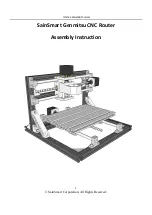
Chapter 1: Configuration
Configuring radio parameters
Page
1-212
Note
Change contention slot configuration in an operating, stable system cautiously and with a
back-out plan. After changing a contention slot configuration, monitor the system closely
for problems as well as improvements in system performance.
Frame calculator for co-location
The frame calculator is a tool available for the PMP 450 series systems, that calculates the length of the
transmit and receive times, together with the number of downlink and uplink symbols, for a given set of
configuration parameters. The frame calculator can be used to verify that co-location of APs using
different contention slots settings does not create overlapping transmit and receive times.
Basic rules
For co-location of AP1 and AP2, we want to ensure that AP1 stops transmitting before AP2 starts
receiving, and that AP2 stops transmitting before AP1 starts receiving.
These are the rules that have to be satisfied for a correct co-location of the two APs:
•
AP1 Receive Start > AP2 Transmit End
•
AP2 Receive Start > AP1 Transmit End
Steps for co-location
Let us assume that in a cluster of multiple APs with all the same settings, one AP’s settings are modified
with a different number of contention slots.
1.
Obtain all configuration settings for the APs that do not change parameters (duty cycle,
contention slots, max distance)
2.
Input these configuration parameters into the OFDM Frame Calculator tool found under “Tools”.
3.
Click “Calculate”
4.
Note the following values from the results:
AP Antenna Transmit End: ____________________
AP Antenna Receive Start: ____________________
5.
Access the AP that needs to have a different contention slots setting and use the frame
calculator tool found under “Tools”
6.
Input the configuration parameters for this AP (same duty cycle and max distance as the other
APs, different contention slots)
7.
Click “Calculate”
8.
Note the following values from the results:
AP Antenna Transmit End: ____________________
AP Antenna Receive Start: ____________________
9.
Check that the two following equations are both true:
AP1 Receive Start > AP2 Transmit End
AP2 Receive Start > AP1 Transmit End
10.
If one or both equations are not true, adjust the duty cycle until they become true (or the max
distance if possible).
Summary of Contents for PMP 450 AP
Page 51: ...Chapter 1 Configuration Quick link setup Page 1 23 ...
Page 155: ...Chapter 1 Configuration Configuring security Page 1 127 ...
Page 163: ...Chapter 1 Configuration Configuring security Page 1 135 ...
Page 164: ...Chapter 1 Configuration Configuring security Page 1 136 ...
Page 193: ...Chapter 1 Configuration Configuring radio parameters Page 1 165 ...
Page 194: ...Chapter 1 Configuration Configuring radio parameters Page 1 166 ...
Page 195: ...Chapter 1 Configuration Configuring radio parameters Page 1 167 ...
Page 206: ...Chapter 1 Configuration Configuring radio parameters Page 1 178 ...
Page 210: ...Chapter 1 Configuration Configuring radio parameters Page 1 182 ...
Page 636: ...Chapter 5 Troubleshooting Logs Page 5 16 Figure 95 SM Authorization log ...
















































